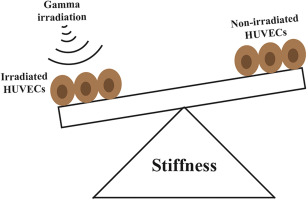Journal of the Mechanical Behavior of Biomedical Materials ( IF 3.3 ) Pub Date : 2018-06-06 , DOI: 10.1016/j.jmbbm.2018.06.009 Alireza Mohammadkarim , Mohammad Tabatabaei , Azim Parandakh , Manijhe Mokhtari-Dizaji , Mohammad Tafazzoli-Shadpour , Mohammad-Mehdi Khani

|
Radiation therapy has been widely utilized as an effective method to eliminate malignant tumors and cancerous cells. However, subjection of healthy tissues and the related networks of blood vessels adjacent to the tumor area to irradiation is inevitable. The aim of this study was to investigate the consequent effects of fractionation radiotherapy on the mechanical characteristics of human umbilical vein endothelial cells (HUVECs) through alterations in cytoskeleton organization and cell and nucleus morphology. In order to simulate the clinical condition of radiotherapy, the HUVECs were exposed to the specific dose of 2 Gy for 1–4 times among four groups with incremental total dose from 2 Gy up to 8 Gy. Fluorescence staining was performed to label F-actin filaments and nuclei. Micropipette aspiration and standard linear solid model were employed to evaluate the elastic and viscoelastic characteristics of the HUVECs. Radiotherapy significantly increased cell elastic moduli. Due to irradiation, instantaneous and equilibrium Young's modulus were also increased. Radiotherapy diminished HUVECs viscoelastic behavior and shifted their creep compliance curves downward. Furthermore, gamma irradiation elevated the nuclei sizes and to a lesser extent the cells sizes resulting in the accumulation of F-actin filaments within the rest of cell body. Endothelial stiffening correlates with endothelial dysfunction, hence the results may be helpful when the consequent effects of radiotherapy are the focus of concern.
中文翻译:

放射疗法影响人脐静脉内皮细胞的机械行为
放射疗法已被广泛用作消除恶性肿瘤和癌细胞的有效方法。然而,不可避免地要对健康组织和与肿瘤区域相邻的血管的相关网络进行辐射。这项研究的目的是通过改变细胞骨架的组织以及细胞和细胞核的形态,研究分级放疗对人脐静脉内皮细胞(HUVEC)力学特性的影响。为了模拟放射疗法的临床状况,在四个组中,将HUVEC暴露于2 Gy的特定剂量下1-4次,总剂量从2 Gy到8 Gy递增。进行荧光染色以标记F-肌动蛋白丝和细胞核。使用微量移液器抽吸和标准线性固体模型评估HUVEC的弹性和粘弹性特征。放射疗法显着增加了细胞的弹性模量。由于辐射,瞬时和平衡杨氏模量也增加了。放疗减弱了HUVEC的粘弹性行为,并使其蠕变柔顺曲线向下移动。此外,伽马射线辐照会增加细胞核的大小,并在较小程度上增加细胞的大小,从而导致F-肌动蛋白丝在其余细胞体内积聚。内皮硬化与内皮功能障碍有关,因此,当放射治疗的后续效果成为人们关注的焦点时,结果可能会有所帮助。放射疗法显着增加了细胞的弹性模量。由于辐射,瞬时和平衡杨氏模量也增加了。放疗减弱了HUVEC的粘弹性行为,并使其蠕变柔顺曲线向下移动。此外,伽马射线照射增加了细胞核的大小,并在较小程度上增加了细胞的大小,从而导致F-肌动蛋白丝在其余细胞体内积聚。内皮硬化与内皮功能障碍有关,因此,当放射治疗的后续效果成为人们关注的焦点时,结果可能会有所帮助。放射疗法显着增加了细胞的弹性模量。由于辐射,瞬时和平衡杨氏模量也增加了。放疗减弱了HUVEC的粘弹性行为,并使其蠕变柔顺曲线向下移动。此外,伽马射线辐照会增加细胞核的大小,并在较小程度上增加细胞的大小,从而导致F-肌动蛋白丝在其余细胞体内积聚。内皮硬化与内皮功能障碍有关,因此当放射治疗的后续效果成为人们关注的焦点时,结果可能会有所帮助。γ射线照射会增加细胞核的大小,并在较小程度上增加细胞的大小,从而导致F-肌动蛋白丝在其余细胞体内积聚。内皮硬化与内皮功能障碍有关,因此当放射治疗的后续效果成为人们关注的焦点时,结果可能会有所帮助。γ射线照射会增加细胞核的大小,并在较小程度上增加细胞的大小,从而导致F-肌动蛋白丝在其余细胞体内积聚。内皮硬化与内皮功能障碍有关,因此当放射治疗的后续效果成为人们关注的焦点时,结果可能会有所帮助。










































 京公网安备 11010802027423号
京公网安备 11010802027423号